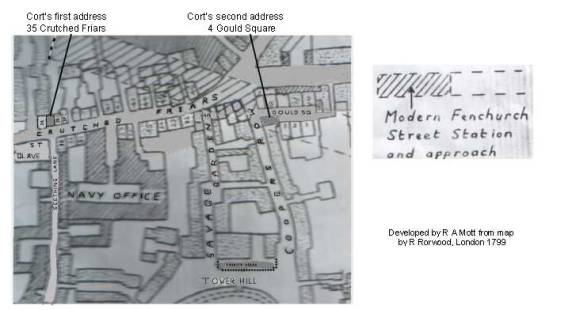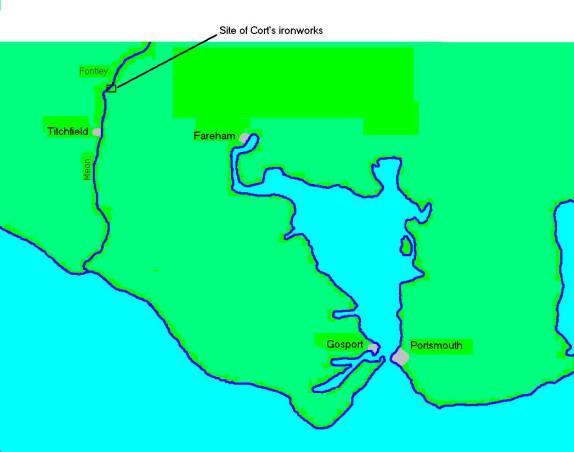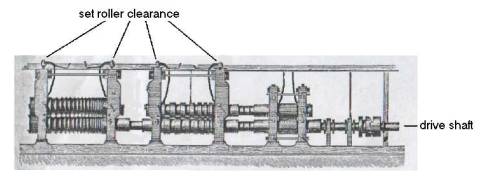 |
 |
Henry Cort Inventor - Creator of puddled iron - Father of iron trade |
 |
 |
| This page is part of a website based on the life and achievements of eighteenth-century inventor Henry Cort. The creator and owner of the site was Eric Alexander who passed away. The site is now hosted by Geneagraphie.com Please contact us with any comments or queries. |
- Homepage
- Life of Henry Cort
- Cort's processes in iron manufacture
- Cort's patents
- Refutation of allegations of conspiracies against Cort
- Adam Jellicoe's death
- Henry Cort's birth
- A navy agent's business
- Early life of John Becher
- Attwick & Burges families
- "Cortship" of second wife
- Thomas Morgan
- Henry Cort's hoops contract
- 1856 Accolade
- Generosity of friends 1789-94
- James Watson
- Illness of Cort's son
- Main sources of information
- Contemporary sources
- Navy sources
- Chancery files
- Publications about Cort
- Assessment of Cort's character
- Images of Henry Cort
Impeach-tranferred to 05
- Parliamentary inquiry 1811-2
- The furore of the 1850s
- Society of Arts
- Cort's first marriage
- Henry Cort's children
- Cort family pensions
- Henry Cort's Hertfordshire property
- 1791 signatories
- Guiana and the Cort-Gladstone connection
- Cort's twilight years
- Memorials to Henry Cort
- Smelting of iron
- Fining before Cort
- Shropshire & Staffordshire ironmasters
- Cumbrians: Wilkinson etc
- Early works at Merthyr Tydfil
- The Crowley business
- London ironmongers
- Scottish iron
- Cort's promotion efforts 1783-6
- Later Merthyr connections
- Puddling after Henry Cort
- Gosport in Cort's day
- Gosport administration
- Gosport worthies
- The Amherst-Porter network
- James Hackman, murderer
- Samuel Marshall
- Samuel Jellicoe's legacy
- Links with Titchfield
- Links with Fareham
- Fact, error and conjecture
- 18th century politics
- Law in the 18th century
- 18th century finance
- Religion and sexual mores
- Calendar change of 1752
- Shelburne, Parry and associates
- John Becher's family
- The Becher-Thackeray lineage
- Thomas Lyttelton: a fantastic narrative
- Eighteenth-century London
- Abolition and the Corts
- The Burges will tangle
- Navy connections
- Navy agent's business
- Cort's clients
- Ships' pursers
- History of Adam Jellicoe
- Dundas & Trotter
- Cort's navy office associates
- Toulmin & other agents
- Sandwich & Middleton
- The Arethusa
- John Becher's war
- Thomas Morgan's war
- The 1782 Jamaica convoy
- Sinking of the Royal George
- Visitors 2006-2009
- Developement of the site 2006-2009
- Daniel Guion and family
- Extremely bad academic work and extremely bad journalism
****************
|
|
LIFE OF HENRY CORT
Cort's birth is supposed to have been in Lancaster in 1740.
Nothing is known of his early life, though some accounts say his father was a builder.
The first documentary evidence comes in October 1757, when Cort is working as clerk to a navy agent, Thomas Bell, in London.
The Navy Office at this time is near the Tower of London, on the corner of Crutched Friars and Seething Lane. Henry soon takes up residence in Crutched Friars.

It is easy enough to follow his career. He must have had some useful financial backing, for he has taken over the firm by 1764 and runs it for ten years.
During this period he marries twice. Little is known about his first wife, but the marriage doesn't last long.
His second wife is Elizabeth Haysham, the sister-in-law of one of his clients, John Becher.
More significantly, she springs from the Attwick family: granddaughter of John Attwick, who has built up a big business in Gosport supplying ironmongery and other items to the Navy in Portsmouth.
John is dead by the time Cort arrives on the scene, and the business is being run by his son William, Elizabeth's uncle.
In 1772 William Attwick is hoping to retire.
Cort suggests another of his clients, Thomas Morgan, as a suitable person to take over the firm.
Morgan first becomes William's partner, then sole owner.
When the American rebellion breaks out, Morgan re-enlists in the Navy.
Cort moves to Gosport to take over the business.
Morgan owes him money, but the whole enterprise is buttressed by a complex web of loans in which one of the main lenders is a Navy Office clerk, Adam Jellicoe.
Early in 1781 the financial arrangements are simplified: Jellicoe becomes the main creditor, Cort the main debtor
|
Mr Cort agreed the 8 January 1781 to sell Mr A Jellicoe: One half of the Iron Mill; One half of Gosport works demised by Mr Attwick; One half of Child's Wharf laid out with improvement; One half of his Contracts at a price to be settled by two indifferent persons; One half of his Stock in trade at a valuation. And in consideration of Mr A Jellicoe settling Mr Cort's affairs and paying his Debts to allow Mr Saml Jellicoe half the Profits of his Contracts and Trade. From Watson-Dundas memorandum, 1790 |
Cort takes on Jellicoe's son Samuel as partner.
Jellicoe continues to finance the enterprise. It looked a promising investment.
Anchors and chains are forged at Gosport, but most of the ironmongery is purchased elsewhere in the country: probably in the West Midlands, although the Cramond works in Scotland is the main supplier of nails for a period.
Cort, however, is experimenting with new techniques in iron manufacture. The Navy at this time prefers to use imported iron.
When France enters the war in 1778, supplies from overseas become more difficult to obtain and prices rise steeply.
The Navy is particularly concerned about the price of hoops, used to seal the casks and barrels that hold ships' provisions.
Cort enters into an arrangement to supply the Navy with iron hoops.
He takes over an old iron mill at Fontley on the River Meon, some 12km from Gosport, and installs new equipment at some considerable cost.

In 1783 and 1784 there are patents awarded for the processes he has developed: two patents in England and Wales, one in Scotland.
The most important process later becomes known as puddling. Its purpose is to remove excess carbon that the iron has absorbed during smelting, to make it workable by a blacksmith. The iron emerges from the puddling furnace as a spongy solid, which is next squashed using a "shingling" hammer.

The final stage is to pass lumps of this solid between rollers, so that it emerges as long bars.
By fitting collars and grooves to his rollers, he can control the size and shape of a bar's cross-section: this part of the process is later adapted for rolling steel.
Before Cort introduced this stage of the process, bars were shaped using heavy hammers, like the water-driven tilthammer said to be at Fonrtley Iron Mill when Cort took it over.
The Navy spends a few years checking the efficacy of Cort's product.
But he is confident enough to start travelling round the country (Wales and Scotland included) to demonstrate his process to other ironmasters. He expects them to adopt it and pay him royalties.
Although they seem to be impressed at first, only one company, at Rotherhithe, gets involved at this stage. There is a snag in the process when freshly-smelted iron is used, caused by impurities which accumulate in the puddling furnace over time.
Cort never appreciates this, because he always works with recycled iron, which does not contain these impurities.
In 1787, however, a new enterprise in South Wales, under Richard Crawshay, takes an interest in Cort's process.
Crawshay adopts it in a big way, installing twelve puddling furnaces where Cort used just one.
Crawshay still runs into the impurity problem, and by the summer of 1789 the agreement with Cort and Jellicoe has broken down.
But Cort has another problem. Some of the money Adam Jellicoe has lent him is Navy money, earmarked for paying seamen's wages.
The point is never reached when money for wages isn't available: nevertheless Jellicoe's bosses at the Navy Office get nervous when they find out what he has done. He assures them he will soon get the money back.
This hasn't happened at the time of Jellicoe's death in August 1789.
The Navy determines to recover the missing money from Cort, and persuades the judiciary that he owes £27,500 to the Crown.
They seize his property and assets, leaving him unable to meet the demands of other creditors. He therefore applies for bankruptcy, granted in October 1789.
The generosity of friends and admirers enables him to set up house in London and pay off the debts not outstanding to the Crown.
In the summer of 1791 a group petitions the Prime Minister on his behalf, and in 1794 he is granted a meagre pension.
He has a wife and twelve children ranging in age from 4 to 25.
He lives for another six years, during which one of his children dies and another is confined to a mental hospital in Calcutta for over a year.
In the following years some of his children attempt to gain public recognition and recompense for his work, and myths are created suggesting he is a victim of conspiracy.
It is in this atmosphere that The Times publishes the 1856 accolade. Accounts like this have coloured subsequent appraisals of Cort, but much has been disproved by evidence recently unearthed at the National Archives and elsewhere.
The pages on this site are copied from the original site of Eric Alexander (henrycort.net) with his allowance.
Eric passed away abt 2012
If you use/copy information from this site, please include a link to the page where you found the information.
